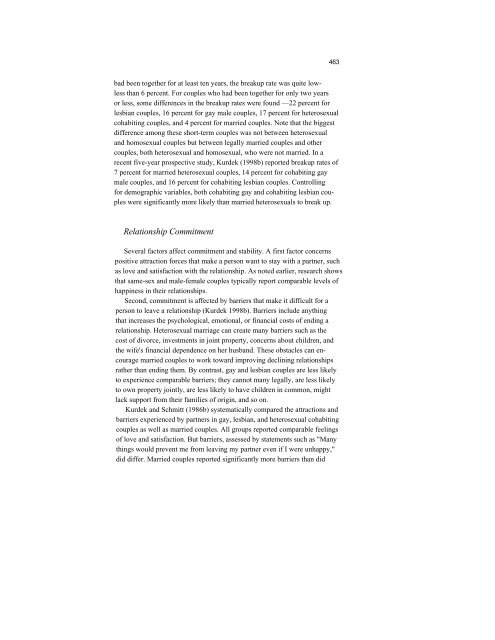17 The Close Relationships of Lesbians, Gay Men, and Bisexuals
17 The Close Relationships of Lesbians, Gay Men, and Bisexuals
17 The Close Relationships of Lesbians, Gay Men, and Bisexuals
You also want an ePaper? Increase the reach of your titles
YUMPU automatically turns print PDFs into web optimized ePapers that Google loves.
463<br />
bad been together for at least ten years, the breakup rate was quite low-<br />
less than 6 percent. For couples who had been together for only two years<br />
or less, some differences in the breakup rates were found —22 percent for<br />
lesbian couples, 16 percent for gay male couples, <strong>17</strong> percent for heterosexual<br />
cohabiting couples, <strong>and</strong> 4 percent for married couples. Note that the biggest<br />
difference among these short-term couples was not between heterosexual<br />
<strong>and</strong> homosexual couples but between legally married couples <strong>and</strong> other<br />
couples, both heterosexual <strong>and</strong> homosexual, who were not married. In a<br />
recent five-year prospective study, Kurdek (1998b) reported breakup rates <strong>of</strong><br />
7 percent for married heterosexual couples, 14 percent for cohabiting gay<br />
male couples, <strong>and</strong> 16 percent for cohabiting lesbian couples. Controlling<br />
for demographic variables, both cohabiting gay <strong>and</strong> cohabiting lesbian cou-<br />
ples were significantly more likely than married heterosexuals to break up.<br />
Relationship Commitment<br />
Several factors affect commitment <strong>and</strong> stability. A first factor concerns<br />
positive attraction forces that make a person want to stay with a partner, such<br />
as love <strong>and</strong> satisfaction with the relationship. As noted earlier, research shows<br />
that same-sex <strong>and</strong> male-female couples typically report comparable levels <strong>of</strong><br />
happiness in their relationships.<br />
Second, commitment is affected by barriers that make it difficult for a<br />
person to leave a relationship (Kurdek 1998b). Barriers include anything<br />
that increases the psychological, emotional, or financial costs <strong>of</strong> ending a<br />
relationship. Heterosexual marriage can create many barriers such as the<br />
cost <strong>of</strong> divorce, investments in joint property, concerns about children, <strong>and</strong><br />
the wife's financial dependence on her husb<strong>and</strong>. <strong>The</strong>se obstacles can en-<br />
courage married couples to work toward improving declining relationships<br />
rather than ending them. By contrast, gay <strong>and</strong> lesbian couples are less likely<br />
to experience comparable barriers; they cannot many legally, are less likely<br />
to own property jointly, are less likely to have children in common, might<br />
lack support from their families <strong>of</strong> origin, <strong>and</strong> so on.<br />
Kurdek <strong>and</strong> Schmitt (1986b) systematically compared the attractions <strong>and</strong><br />
barriers experienced by partners in gay, lesbian, <strong>and</strong> heterosexual cohabiting<br />
couples as well as married couples. All groups reported comparable feelings<br />
<strong>of</strong> love <strong>and</strong> satisfaction. But barriers, assessed by statements such as "Many<br />
things would prevent me from leaving my partner even if I were unhappy,"<br />
did differ. Married couples reported significantly more barriers than did
















